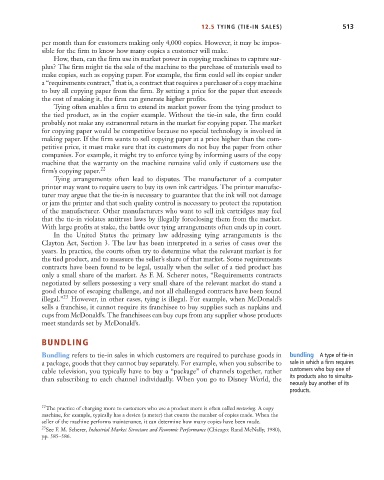Page 539 - Microeconomics, Fourth Edition
P. 539
c12capturingsurplus.qxd 7/22/10 10:41 AM Page 513
12.5 TYING (TIE-IN SALES) 513
per month than for customers making only 4,000 copies. However, it may be impos-
sible for the firm to know how many copies a customer will make.
How, then, can the firm use its market power in copying machines to capture sur-
plus? The firm might tie the sale of the machine to the purchase of materials used to
make copies, such as copying paper. For example, the firm could sell its copier under
a “requirements contract,” that is, a contract that requires a purchaser of a copy machine
to buy all copying paper from the firm. By setting a price for the paper that exceeds
the cost of making it, the firm can generate higher profits.
Tying often enables a firm to extend its market power from the tying product to
the tied product, as in the copier example. Without the tie-in sale, the firm could
probably not make any extranormal return in the market for copying paper. The market
for copying paper would be competitive because no special technology is involved in
making paper. If the firm wants to sell copying paper at a price higher than the com-
petitive price, it must make sure that its customers do not buy the paper from other
companies. For example, it might try to enforce tying by informing users of the copy
machine that the warranty on the machine remains valid only if customers use the
firm’s copying paper. 22
Tying arrangements often lead to disputes. The manufacturer of a computer
printer may want to require users to buy its own ink cartridges. The printer manufac-
turer may argue that the tie-in is necessary to guarantee that the ink will not damage
or jam the printer and that such quality control is necessary to protect the reputation
of the manufacturer. Other manufacturers who want to sell ink cartridges may feel
that the tie-in violates antitrust laws by illegally foreclosing them from the market.
With large profits at stake, the battle over tying arrangements often ends up in court.
In the United States the primary law addressing tying arrangements is the
Clayton Act, Section 3. The law has been interpreted in a series of cases over the
years. In practice, the courts often try to determine what the relevant market is for
the tied product, and to measure the seller’s share of that market. Some requirements
contracts have been found to be legal, usually when the seller of a tied product has
only a small share of the market. As F. M. Scherer notes, “Requirements contracts
negotiated by sellers possessing a very small share of the relevant market do stand a
good chance of escaping challenge, and not all challenged contracts have been found
illegal.” 23 However, in other cases, tying is illegal. For example, when McDonald’s
sells a franchise, it cannot require its franchisee to buy supplies such as napkins and
cups from McDonald’s. The franchisees can buy cups from any supplier whose products
meet standards set by McDonald’s.
BUNDLING
Bundling refers to tie-in sales in which customers are required to purchase goods in bundling A type of tie-in
a package, goods that they cannot buy separately. For example, when you subscribe to sale in which a firm requires
cable television, you typically have to buy a “package” of channels together, rather customers who buy one of
than subscribing to each channel individually. When you go to Disney World, the its products also to simulta-
neously buy another of its
products.
22 The practice of charging more to customers who use a product more is often called metering. A copy
machine, for example, typically has a device (a meter) that counts the number of copies made. When the
seller of the machine performs maintenance, it can determine how many copies have been made.
23 See F. M. Scherer, Industrial Market Structure and Economic Performance (Chicago: Rand McNally, 1980),
pp. 585–586.

